Oxford University Press's Blog, page 527
April 2, 2016
LBJ drops out of 1968 presidential race
By late March 1968, President Lyndon Johnson’s presidency lay in tatters. Anger over the war in Vietnam and Johnson’s growing credibility gap had created a full-scale insurgency at home, within the Democratic Party. On 12 March, Minnesota Senator Eugene McCarthy won more than 40% of the vote against Johnson in the New Hampshire primary.
Days later, Robert F. Kennedy, Johnson’s greatest political nemesis, announced his intention to also challenge the president. I had been expecting it,” Johnson later matter-of-factly wrote in his memoirs about Kennedy’s entry into the race.
On the campaign trail, Kennedy seemed to be blaming every national infirmity on the president. At the Greek Theater in Los Angeles, he even went to far as to accuse Johnson of “calling upon the darker impulses of the American spirit.”
With Democratic voters in Wisconsin prepared to head to the polls on 3 April all signs pointed to Johnson suffering a catastrophic primary defeat to McCarthy’s energized and confident foot soldiers. Nationally, Johnson’s approval rating sank to 36 percent, and support for his handling of Vietnam plummeted to 26 percent. Missouri senator Stuart Symington told a closed-door meeting of his Senate colleagues, “Lyndon Johnson could not be elected dogcatcher in Missouri today.”
Beyond his immediate political challenges, a larger emotional toll was being taken on the president. He regularly shuffled from his personal quarters to the Situation Room in the basement of the White House in his bathrobe and slippers. In a meeting with his old friend Senator Richard Russell, he began crying uncontrollably. He felt “chased on all sides” by the growing dissent and anger over the war, the “inflationary economy,” and the “rioting blacks, demonstrating students, marching welfare mothers, squawking professors, and hysterical reporters.” Not since Lincoln had an American president faced as much domestic dissent as that which confronted Johnson in the spring of 1968.
Things soon went from bad to worse. On 26 March he met with a group of foreign policy “Wise Men” to discuss the situation in Vietnam – including former Secretary of State, Dean Acheson and LBJ’s own former national security advisor McGeorge Bundy. Two months earlier, the Vietcong and North Vietnamese had launched the massive Tet offensive, which punctured the White House’s argument that the war was being won.
Bundy, told Johnson, it was now clear that “we can no longer do the job we set out to do in the time we have left and we must begin to take steps to disengage.” The men who had built and nurtured a two-decade long policy of Soviet and Communist containment and now told a stunned president that the war on which he’d staked his presidency had all been for naught.
Five days later, on 31 March 1968, Johnson spoke to the nation from the Oval Office. “With America’s sons in the fields far away,” he told the American people in a deliberate and steady, but melancholy-filled tone, “with America’s future under challenge right here at home, with our hopes and the world’s hopes for peace in the balance every day, I do not believe that I should devote an hour or a day of my time to any personal partisan causes or to any duties other than the awesome duties of this office…. Accordingly, I shall not seek, and I will not accept, the nomination of my party for another term as your President.”
Johnson had long flirted with the possibility of not running for president. According to his chief of staff, Marvin Watson, LBJ said privately in January 1968 that he wouldn’t run. He had even asked his speechwriters to write up an addendum to his State of the Union address, announcing his withdrawal from the presidential campaign, which he allegedly “forgot” to bring to the Capitol. In mid-February he revisited the topic and was, according to one aide, “adamant” in his “determination to withdraw.” While he clearly appeared to be leaning toward dropping out, he also clearly had yet to make a final call.
In the end, no single knock-out punch drove Johnson from the race. Rather, a steady drumbeat of body blows felled him: Vietnam; McCarthy’s strong performance in New Hampshire; that son-of-a-bitch Bobby; a Congress that no longer bent to his will; and, finally, the Wise Men. It was what LBJ biographer Doris Goodwin called “the total impossibility of his situation.” Now events outside Johnson’s control, events he could no longer manipulate, forced a decision upon him.
The vigor and vitality with which Johnson had once stridden across the national stage seemed like a faint memory. The pressures of the job had overwhelmed and ultimately defeated him. “I’m tired,” he told friends. “I’m tired of feeling rejected by the American people. I’m tired of waking up in the middle of the night worrying about the war. I’m tired of all these personal attacks on me.”
Johnson’s announcement left many of the nation’s most prominent politicians at an uncharacteristic loss for words. “I don’t know quite what to say,” stammered Kennedy. Said McCarthy, “I think I’m surprised,” and, more drily, “Things have gotten rather complicated.” Barry Goldwater had perhaps the most down-to-earth reaction. “I went and had another drink. I just couldn’t believe my ears.”
On the morning of 31 March, Johnson seemed to his political opponents (and to some of his political allies) a sick, even deranged, man not to be trusted or believed. On 1 April 1968, he had been transformed into a selfless American hero who had fallen on his political sword for the good of the country. His 57 percent disapproval rating flipped to a 57 percent approval rating practically overnight.
Days after what Time called “the renunciation,” Johnson traveled to New York for the installation of the city’s new archbishop. As he walked down the center aisle of Saint Patrick’s Cathedral, the congregation of five thousand rose in a sustained standing ovation (an almost unheard-of occurrence inside a Catholic church). Equally euphoric were the crowds outside.
The outpouring of appreciation was about more than just Johnson’s abrupt exit from national politics. In his 31 March speech he announced that he would be pursuing a policy of de-escalation in Vietnam and preparing to “move immediately toward peace through negotiations” with the North Vietnamese. It gave Americans hope that an end to the war was possible. For a brief moment it appeared that the seemingly relentless process of national disintegration that the country had experienced in the first three months of 1968 could be reversed.
Four days later in Memphis, Tennessee those hopes would be dashed.
See President Johnson’s full speech below.
Feature Image: The Flag of the United States by Sam Howzlt. CC BY 2.0 via Flickr.
The post LBJ drops out of 1968 presidential race appeared first on OUPblog.

Francisco Goya’s deafness
By the time Francisco Goya died during this month in 1828, he had established himself as one of the greatest portraitists of modern times. During his 74 years, he featured both nobles and kings and humble workers and farmers in over 1,800 works. It is said that he painted at a pace so furious, he completed his wife’s portrait, now hanging in the Prado, in an hour, finished King Fernando’s huge painting in just one or two sessions, and produced the portrait of the Infante Don Louis in a single morning. No artist before or since then has executed a lifelike portrait so perfectly in so short a time.
 Portrait of Josefa Bayeu (1747-1812), Francisco Goya’s wife, by Francisco Goya. Public Domain via Wikimedia Commons.
Portrait of Josefa Bayeu (1747-1812), Francisco Goya’s wife, by Francisco Goya. Public Domain via Wikimedia Commons.In the winter of 1792-93, when Goya was 46, he developed a mysterious illness that nearly killed him. He survived but lost his hearing, and for the next 35 years was “deaf as a stump.” Of the nearly two dozen diagnoses that had been proposed as the cause of that illness, none fits the nature of the disorder better than a viral encephalitis, and of those viruses known to cause an encephalitis that results in deafness, none was more likely to have been responsible for destroying Goya’s hearing than the mumps virus.
The effect of Goya’s deafness on his work has long been debated. It forced him to resign his teaching post at the Royal Academy in Madrid, after robbing him of “all hope of giving any assistance [there], since [he] was unable to hear anything that the pupils said… and this led to general amusement among the boys and disruptions of the class.” But was the deafness also responsible for the radical change in the character of Goya’s art that evolved in the aftermath of his illness? Before he lost his hearing, he painted gentle, colorful scenes of picnics and games and produced elegant tapestries and cartoons in the Rococo style. Afterward, many of his works became dark and nightmarish, depicting a merciless, often vengeful view of the world. He became obsessed with disaster and mayhem and created works that nearly always carried the stamp of scorn. And yet, only after the illness did he achieve full mastery of the face in his portraits. Only after his hearing was gone did his skill as a portraitist reach its zenith, possibly, it has been suggested, because deafness made him more aware of gesture, physical expression, and all the minute particulars of how faces and bodies reveal themselves.
This transformation followed Goya’s illness, but was it caused by the illness? Did his deafness cause him to rebel against his fate through his art and produce the morbid images that populated later works, or were other traumas responsible–his wife’s numerous miscarriages, for example, or Spain’s agony under the yoke of a corrupt administration, or later, the ravages of the Peninsular War and French occupation? Although the answers to these questions will never be known for certain, the uncertainty only adds to the sense of mystery evoked by his works, perhaps too, the eternal sense of beauty and pity and pain he succeeded in conveying through his art.
Featured image credit: Witches’ Sabbath, from the Black Paintings Series by Francisco Goya. Public Domain via Wikimedia Commons.
The post Francisco Goya’s deafness appeared first on OUPblog.

Today’s Forecast: Cloudy with a chance of seizures
For people suffering from recurrent epileptic seizures, one of the most burdensome aspects of their condition is the unpredictability of their seizures. While medications, resective surgery, and novel neurostimulation methods can eliminate seizures, for many people with epilepsy the potential for seizures is a daily reality. This places profound limitations on daily activities, and people with epilepsy cannot drive a car, swim, bathe an infant, or perform any other activity where a momentary loss of consciousness could prove catastrophic. For someone whose seizures occur rarely, these few seizures have a disproportionate impact on their daily lives.
For many years there has been an effort in the neurology, computer science, and engineering communities toward developing algorithms to detect subtle changes in the electrical activity of a person’s brain (measured by electroencephalography) before a seizure occurs. This has been a challenge, and the difficulty of obtaining large quantities of suitable data for algorithm development and testing has slowed progress. Many early research reports developed and tested algorithms on relatively short intracranial EEG data segments from patients with epilepsy undergoing monitoring to identify the focal seizure onset zone before surgical resection. There are a number of problems with this. First, patients undergoing presurgical monitoring for epilepsy typically have their medications reduced to encourage seizures to occur, which causes a progressive decrease in the blood levels of medications which have been shown to affect the normal baseline pattern in a patient’s EEG. Second, hospital stays for presurgical monitoring by necessity rarely last more than two weeks, providing a very limited amount of data for any single patient. These short data segments with changing baseline EEG characteristics are particularly problematic when algorithm scientists attempt to measure an algorithm’s false positive rate, or the number of false alarms that a seizure forecasting algorithm might raise. In addition, data and algorithm programs have only rarely been shared between researchers, making direct comparisons among algorithms difficult.
In 2013 a group of physicians and scientists from Melbourne Australia published a successful trial of an implanted device capable of measuring EEG from intracranial electrode strips, and telemetering the EEG data to a small external device about the size of a smart phone that could run seizure forecasting algorithms and provide warnings of impending seizures. The device used a proprietary seizure forecasting algorithm that performed adequately, validating the concept that seizure forecasting could become a useful supplement to existing epilepsy therapies.
Kaggle.com runs data science competitions to develop algorithms to predict everything from insurance fraud to customer satisfaction to the Higgs Boson – and we made an effort to use kaggle.com to develop new algorithms for seizure forecasting. We uploaded intracranial EEG data from a device implanted in eight dogs with naturally occurring epilepsy, that recorded nearly 350 seizures over 1,500 days in total, as well as data from two human patients undergoing intracranial monitoring. In hope of winning $15,000 in prize money, plus bragging rights among elite data science circles, hundreds of algorithm scientists, most with little or no experience with epilepsy or EEG, worked countless hours to develop algorithms for seizure forecasting. After three months, over half of these “crowdsourced” algorithms performed better than random chance, and the top performing algorithms accurately predicted over 70% of seizures with a 25% false positive rate. The data are available for researchers to continue developing new algorithms for predicting seizures, and can serve as a benchmark for new algorithms to be compared directly to one another and to the algorithms developed in this competition. The best performing algorithms in the competition used a mixture of conventional and complex approaches drawn from physics, engineering, and computer science, sometimes in unorthodox ways that proved to be surprisingly effective.
While we applaud the talented algorithm scientists who took home the prize money, we hope the real winners of the contest will be our patients.
Featured image: Sky cloudy. Uploaded by Carla Nunziata. CC-BY-SA-3.0 via Wikimedia Commons
The post Today’s Forecast: Cloudy with a chance of seizures appeared first on OUPblog.

Food economics: a reading list
Agriculture is a means of living for a large percentage of the world’s population. Agricultural economics looks at the utilization and distribution of farming resources and aims to apply the principles of economic theory to farming and the production and allocation of food in order to optimize such processes. This month the annual conference of the Agricultural Economics Society is taking place, and to raise further awareness of this significant field of economics, we have created a reading list of books, journals, and free online resources that explore the varied areas of food and agricultural economics, and how they affect different areas of our lives.
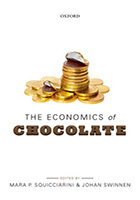
The Economics of Chocolate edited by Mara P. Squicciarini and Johan Swinnen
This book, written by global experts, provides a comprehensive and topical analysis on the economics of chocolate. While the main approach is economic analysis, there are important contributions from other disciplines, including psychology, history, government, nutrition, and geography. Read chapter 1.
The Oxford Handbook of the Economics of Food Consumption and Policy edited by Jayson L. Lusk, Juttta Roosen, and Jason Shogren
Historically, the challenge for humans has been to secure a sufficient supply of food to stave off hunger and starvation. As a result, much of the research on food and agriculture in the past century has focused on issues related to production efficiency, food supply, and farm profitability. In recent years, however, the attention has turned away from the farm and toward the food consumer and to issues related to food consumption. This handbook provides an overview of the economics of food consumption and policy. Read a free chapter.
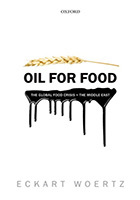
Oil for Food: The Global Food Crisis and the Middle East by Eckart Woertz
Oil for Food draws on extensive sources and interviews to tell the story of how Arab Gulf countries reacted to the 2008 global food crisis. It argues against the hype created around so called ‘land grabs’ and analyses the geopolitical implications behind the investment drive of Arab Gulf countries in food insecure countries like Sudan or Pakistan. Read chapter 2.
The Evolving Sphere of Food Security by Rosamond L. Naylor
How do the policies used to promote food security in one country affect nutrition, food access, natural resources, and national security in other countries? How do the priorities and challenges of achieving food security change over time as countries develop economically? The author seeks to answer these two important questions and others by exploring the interconnections of food security to security of many kinds: energy, water, health, climate, the environment, and national security.
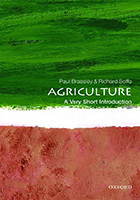
Agriculture: A Very Short Introduction by Paul Brassley and Richard Soffe
Agriculture, one of the oldest human occupations, is practised all over the world, using techniques ranging from the profoundly traditional to the most scientifically advanced. Without it we would starve. In this Very Short Introduction Paul Brassley and Richard Soffe explain what farmers do and why they do it.
Agricultural and Food Controversies, What Everyone Needs to Know by F. Bailey Norwood, Michelle S. Calvo-Lorenzo, Sarah Lancaster, and Pascal A. Oltenacu
In this book agricultural researchers present both sides of heavily debated agricultural and food issues. They answer questions and explain scholarly and scientific research on topics such as organic food, the safety of pesticides, livestock living conditions, the use of antibiotics in livestock intended for consumption, the effect of agriculture on the environment, and more.
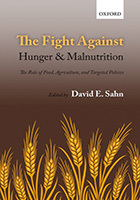
The Fight Against Hunger and Malnutrition, The Role of Food, Agriculture, and Targeted Policies by David E. Sahn
This book details strategies and practical approaches designed to alleviate hunger and malnutrition in a new era where technological change, markets, patterns of governance, and social programs have an increasingly global dimension. Read chapter 8.
American Journal of Agricultural Economics
The American Journal of Agricultural Economics provides a forum for creative and scholarly work on the economics of agriculture and food, natural resources and the environment, as well as development economics.
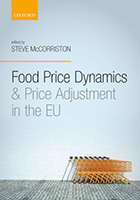 Food Price Dynamics and Price Adjustment in the EU by Steve McCorriston
Food Price Dynamics and Price Adjustment in the EU by Steve McCorriston
This book addresses the important issue of food prices across EU Member States. Although recent attention has focused on events in world commodity markets following the spikes in world prices in 2007-2008 and 2011, there has been comparatively little attention addressing food price dynamics at the retail level. This volume addresses the characteristics of retail food price behaviour and the nature and drivers of price transmission across the EU. Read chapter 2.
European Review of Agricultural Economics
The European Review of Agricultural Economics is now firmly established as the pre-eminent forum for the discussion and dissemination of theoretical and applied agricultural economics research in Europe, with a readership that extends worldwide, covering topics including genetically modified food, corporate social responsibility, and behavioural economics.
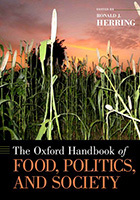
The Oxford Handbook of Food, Politics, and Society edited by Ronald J. Herring
Politics decides who gets what and how. At the most elemental level, food has, for most of our history, been intensely political: who gets to eat what, how often, and through what means of acquisition or entitlement? The Oxford Handbook of Food, Politics, and Society confronts the issue of food in politics through three major dimensions: ecology, technology and property. Read a free chapter.
Featured image credit: Agriculture by StateofIsrael. CC-BY-2.0 via Flickr.
The post Food economics: a reading list appeared first on OUPblog.

From reconstruction to globalization: Shakespeare as he is today
How do we understand Shakespeare today versus one hundred, two hundred, or three hundred years ago? Through efforts like archaeological digs and excavations, studies of word spelling and linguistic patterns, researchers and experts can reconstruct an early modern theatre experience: plays performed in original pronunciation inside facsimile Elizabethan theatres. The Bodleian Libraries, Folger Shakespeare Libraries, and many others have created online, open-access copies of The First Folio, which enable his work to be obtained quickly, easily, and globally. The extent of Shakespeare research and performance is truly boundless as it is continually and freshly explored. Indeed, seeking Shakespeare today does not end with seeking the Shakespeare of 400 years ago, but finding Shakespeare in our modern world, constantly re-evaluating and re-interpreting him in the 21st century.

Download the infographic as a PDF or JPG.
Featured Image: “Shakespeare’s Birthplace, Stratford-upon-Avon – Sept 2012” by Diliff. CC BY-SA 3.0 via Wikimedia Commons
The post From reconstruction to globalization: Shakespeare as he is today appeared first on OUPblog.

Is Christian selflessness oppressive?
It is not uncommon to hear contemporary theologians (and others) opine that the Christian ethic of selflessness is a long-standing cause of female oppression. Even anorexia, that increasingly wide-spread disorder, has been traced back to Christian understandings of love as selfless or self-denying. The notion of selfless love has consequently acquired an air of the psychologically dangerous and patriarchal, and an ethic of self-affirmation and self-assertion has been taking its place.
Linking Christianity to women’s frequent lack of self-confidence or self-worth, and to the social and political disempowerment seeming to result from this, has its reasons. Among these is the fact that Christianity does draw a particular connection between selfless love and femininity: its chief exemplar of holiness—Mary—is, after all, a woman. Although this is the stuff of legend, some of Christianity’s female saints have also prided themselves on living solely on the Eucharist, a claim or practice that has, again, been interpreted as an early form of anorexia.
Despite such compelling connections, the idea that the Christian ethic of selflessness undermines the individual’s self-worth and social standing is complicated, among other things, by the biographies of many of Christianity’s women saints. Whether it be Teresa of Avila, Edith Stein or Dorothy Day—all of these women espoused and pursued strong versions of the Christian ethic of selfless love or self-denial, and yet wielded far-reaching political, intellectual and social influence. Committed to strict routines of prayer and fasting, renouncing material pleasures, and caring for the needy, these women, in their individual ways, pursued the idea of loving others and ‘dying to self’.
 Close examination, by Georgie Pauwels, CC-BY-2.0 via Flickr.
Close examination, by Georgie Pauwels, CC-BY-2.0 via Flickr.Yet Teresa of Avila also reformed an entire religious order and founded large numbers of monasteries, Edith Stein left a lasting philosophical legacy and offered consolation to her fellow Jews during the Holocaust, and Dorothy Day became a successful advocate for workers’ rights. However difficult it may be for us to grasp, selflessness and individual empowerment have not always been perceived as mutually exclusive.
This should give us pause. All too quick a dismissal of selfless love may do more harm than good. For, when it comes to the self’s stature, scope and influence, less may be more: liberation from the more debilitating forms of concern with self can be a key precondition for those actions in the world which boost a person’s confidence and recognition. Similarly, genuine self-denial helps build moral strength or character, without which authentic power and authority are impossible. By contrast, wilful self-assertion can drain the individual, to the point where he/she is too exhausted to uphold his/her artificially claimed power and authority.
Such a perspective relies, perhaps, on a Christian acknowledgement of human sinfulness, or of the individual’s need to overcome his/her typical self-enclosure before being capable of genuine relationship. But acknowledging a link between ‘dying to self’ and ‘coming into one’s own’ also ties in with today’s philosophical conviction that it is through and with ‘the other’ that human beings are shaped as individuals—or that they become fully integrated, strong and healthy persons. And here one is only a step away from a new understanding of Christian selflessness, and of the life-giving potential it claims for itself.
Featured image credit: Dome, by Hernán Piñera, CC-BY-SA 2.0 via Flickr.
The post Is Christian selflessness oppressive? appeared first on OUPblog.

April 1, 2016
Hey everybody! Meet the new team!
Every spring, an extraordinarily talented group comes to Oxford University Press to live, learn, and grow. We’re thrilled to announce that this April, some members will joining the social media team for the first time. We sat down with J.G. Mallard, J.K. Fowling, William Ducksworth, Philip K. Duck, and Alexander to discover what they love about Oxford, what gets them excited about social media, and what they hope to accomplish.
What made you decide the OUP quad was the best place to be?
J.G. Mallard: I believe I work well as both an individual and as part of a team. Working in the OUP quad gives me a great platform to showcase this as I can either provide moral support to my strange looking human colleagues by waddling along by their feet – or I can do the same thing as part of a team. I’m versatile like that.
J.K. Fowling: I love humans that don’t chase me away, nice grass to waddle on, free bagels, and books. OUP fit the bill perfectly.
William Ducksworth: This was my first time flying to Oxford, and it was the perfect place to be, it reminds me so much of my old work place. It’s a joy to be working here the view is very picturesque. It’s also a great way to meet new people, I get to quack everyone a good morning as they enter. Plus, loads of books to get my beak into.
Philip K. Duck: I read about it on “Don’t Fly into that Glassdoor.” You have to take all the reviews with a crumb of bread but everyone was raving about working at the OUP pond.
Alexander: Quack Quack.
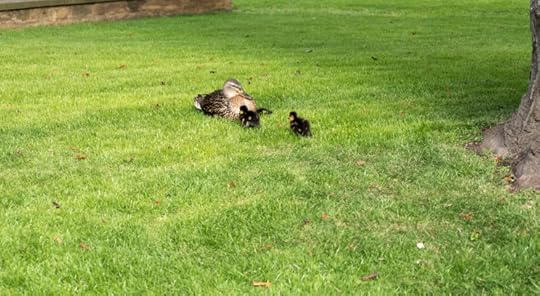 Time for a meeting.
Time for a meeting.Tell us about your colleagues. What distinguishes them so far?
J.G. Mallard: They’re the funniest ducks in all of Oxford. They’re always quacking me up.
J.K. Fowling: There are no lame ducks here. Everyone is super talented and quackers about social media.
William Ducksworth: Well, no one’s ruffled my feathers so far. Everyone is great and friendly. From my first day they have made sure I felt very welcomed and no different. I feel like I’m part of a family.
Philip K. Duck: Attention to detail, for sure. They are great at picking up all the crumbs. I’m more of a big picture duck—all about that whole slice of bread and how I can fit it in my beak and carry it around.
Alexander: Quack Quack Quack.
What do you hope to bring to OUP?
J.G. Mallard: I know thousands of humans read the OUPblog every day but no ducks that I know read it. Do you know why that is? It’s because it doesn’t address hard-hitting duck issues. Where is best to swim? Which humans are most likely to share their lunches with you? That’s what I’ll bring to the table, the real state of current affairs.
J.K. Fowling: Sometimes I feel like our human friends don’t fully understand us. Perhaps a new weekly feature on the OUPblog will elucidate things. I’ll call it “The Oxford Beaktymolygist.”
William Ducksworth: A quacking sense of humour and enthusiasm. Working on the social media team we can reach out to more of the duck community hopefully, (and other bird friends) and showcase what humans do. I hope this is the start of more human-duck work collaborations.
Philip K. Duck: I hope to ruffle a few feathers, really alter humans’ perceptions of what social media can be.
Alexander: Quack Quack.
And in the reverse, what new skills and knowledge do you hope to gain here?
J.G. Mallard: To be honest, I’m happy with what I can do, and anything I don’t understand I can wing it.
J.K. Fowling: I can’t wait to learn all about the best local swimming holes around here from my fellow ducks.
William Ducksworth: I would really like to improve on my public speaking. I’m quite shy and I think I intimidate humans with my quacks. Now working in publishing I’d love to hear more about human authors and literature. I’d also like to improve my coding abilities.
Philip K. Duck: I’m excited to use Hootsuite. I’ve only met a few owls in my life, so I’m excited to work with some.
Alexander: Quack.
 Head to the canteen for lunch or eat at the pond?
Head to the canteen for lunch or eat at the pond?How have you adjusted to OUP’s work culture?
J.G. Mallard: Do you know what, I love everything about working at OUP and it’s all gone swimmingly so far… except for one thing – the canteen. I’ll tell you why. It was my first day and I’d built up quite an appetite running the Oxford Fortune Cookie on Twitter and, subsequently, dreamt of eating actual cookies. So I headed into the canteen and that smell hit me. It was horrible. It reminded me of when I went on a duck holiday to Australia and my little brother stayed out in the sun too long. I couldn’t quite put my finger on it but I decided that packed lunches would be best for me from then on…
J.K. Fowling: I really have been able to spread my wings and fly here – really. It’s so much easier getting to team meetings this way.
William Ducksworth: When I started I did feel like a small duck in a big pond, but everything at OUP is great, I can’t complain. The cafeteria is amazing and there is always something to do here. I’m thinking of joining the drama society.
Philip K. Duck: I’ve always been a Mac duck, so it takes getting used to working on Windows.
Alexander: Quack Quack Quack Quack Quack.
What’s your favorite social media platform and why?
J.G. Mallard: I don’t want to ruffle any feathers but I actually love Instagram. For some reason, humans think that just because we don’t have opposable thumbs – or thumbs of any description – we can’t take a good selfie. How wrong they are. I’ll gladly take on any of those stretched-out human folk in an Instagram competition. I’ll take a selfie and they can take a selfie and we’ll see which one gets more likes shall we? Clue, it won’t be the creatures with the short beaks.
J.K. Fowling: I may be biased but I do have to support my fellow Aves. I am a huge fan of Twitter and its concise publishing format. I do wish updates were called “quacks” instead of “tweets” though…
William Ducksworth: I feel Pinterest is really underrated, it’s been a life saver when it comes to present ideas or flying destinations.
Philip K. Duck: Twitter, for keeping in real-time touch with family and friends. And Snapchat, because even ducks are not immune to the joys geo-filters.
Alexander: Quack Quack.
How does social media help you connect with the wider world?
J.G. Mallard: Makes it easier to speak to my Mum I guess. She’s based hundreds of kilometres away so a quick DM is easier than flying all the way there.
J.K. Fowling: It never sleeps. From the quack of dawn to the middle of the night, information from all over the world is constantly being shared, reposted, and liked. It’s almost difficult to stay out of touch.
William Ducksworth: I’ve met many a ducks who love the same things as I do, such as forums and message boards for my favourite show Beaking Bad.
Philip K. Duck: It helps me keep tabs on my friends and family during migration. We all have our different preferences—I like to check out Key West when it gets cold up here. Social media lets me keep tabs on the ducks I know in Mexico, Mallorca, etc. Plus, I love live-tweeting How to Get Away With Murder.
Alexander: Quack Quack.
Any final words?
J.G. Mallard: You don’t have to be quackers to work in social media at OUP, but it certainly helps.
Alexander: Quack.
The post Hey everybody! Meet the new team! appeared first on OUPblog.

Launching into oral history
Today we return to our ongoing series in which we ask a variety of oral history professionals and practitioners how they ended up in the audio world and why they love oral history. Today Adrienne Cain discusses how she went from future astronaut to oral historian, and the value she sees in preserving the spoken word. To share your own story, contact our social media coordinator, Andrew Shaffer, at ohreview[at]gmail[dot]com.
I was introduced to oral history while completing my Master’s in Library Science at the University of North Texas. I needed to fulfill my practicum requirement, and I took a chance on an advertisement to intern at NASA-Johnson Space Center. (I grew up wanting to be an astronaut, but in high school I met AP Calculus and that dream was indefinitely deferred.) The internship involved working with their History Office, which is where I had the pleasure of meeting Rebecca Wright, Sandra Johnson, Jennifer Ross-Nazal, and Mark Scroggins, and a host of other wonderful people. During that tour we did not conduct any interviews, however we did have a brief session of what an oral history is, how the History Office conducts them, what equipment they use, and how they promote them. At that point I didn’t know or understand why I was so intrigued by this, but it definitely would come in helpful in the future. I completed two tours at NASA-JSC, the first with the History Office and the second with the Information Resources Directorate in which I worked with multimedia digitization. I graduated in December of 2010, but it would be nearly two years before I would begin working in the field.
In October 2012, I began working in the African American Library at the Gregory School in Houston under the direction of Hellena Stokes. I was the Oral History Librarian and knowing that my limited experience was only enough to get my foot in the door, I dove in headfirst. I sought out oral history resources such as Baylor University Institute for Oral History and the Texas Oral History Association (TOHA). Everyone with the Institute was so helpful and accessible, and their webinar is a great tool for people who are new to the field. I also gathered information and best practices from the Oral History Association and looked at different oral history programs across the county. I joined TOHA and took their online webinar “Getting Started with Oral History.” All of the oral histories conducted with the Gregory School are video recordings, so I rearranged the studio to include a backdrop and additional lighting to improve the visual quality of the recordings. I took our mission statement and began to build the oral history program around it. I sought out possible interviewees by reading local papers, cold-calling, emailing, and writing letters to businesses, schools, and local organizations. I loved every minute of it. I was learning so much about the history of African Americans in Houston (which at the time was not well documented), and making connections with people from all walks of life: politicians, educators, community activists, authors, church leaders, and more. Also, these efforts led to the TOHA’s Mary Faye Barnes Award for Excellence in Community Oral History.
In 2014, I received a promotion and moved to another special collections library under the Houston Public Library umbrella, the Houston Metropolitan Research Center. Along with the move came a new title—Oral History and Media Librarian. Not only am I now responsible for the creation and curation of oral histories on various media, I am also responsible for the care and curation of audiovisual materials in our archive. Here I focus on gathering oral histories that encompass all of the city’s history. Houston is one of the most diverse cities in the United States, and there are a lot of great stories to gather and be shared.
Building on what I’ve learned, I am now helping to create the next generation of oral historians.
Building on what I’ve learned, I am now helping to create the next generation of oral historians. I conduct tutorials and give classroom presentations on the importance of oral histories and basic tools to start an oral history project. Every semester Mika Selley, the Hispanic Collections Archivist, and I partner with a local history professor, Dr. Jesse Esparza, to bring his students into the archives for research. A part of their curriculum is to create oral histories based on the subject he provides. At the end of the semester they have a showcase of the work they’ve done and the quality of work they produce is impressive. I convinced Dr. Esparza to present at the TOHA Annual Conference this April and this will be the first professional conference many of the students have ever attended.
I put together presentations based on my findings and research for conferences as well. This past October I presented at the 2015 OHA Annual Meeting in Tampa, FL. This was my second time presenting at the conference, and it’s always a great experience. I encourage anyone interested in oral history to attend. You meet people from all over the world who share the same passions, anxieties, excitements, and headaches in the field. You have experts who are willing and available to share their expertise. You make great connections with people, and believe me those connections come in very handy down the line. (Big thank you to my mentor, Troy Reeves, for dealing with me.) In addition to OHA, I’ve presented at TOHA’s Annual Meeting and will be presenting at the Texas Library Association’s Annual Meeting here in Houston this April.
I believe oral history is important because it provides a different view of history than what we are given in textbooks. Oral histories provide first-hand accounts of moments and events in history. It is one thing to read how veterans struggled with racism during World War II, but to actually hear and see that veteran’s emotion as they recount events is a completely different experience. Oral history makes the past seem more real for those who may not have experienced it.
I love what I do. As far as what the future holds, I know I plan to continue my journey in the field of oral history. Currently, I am a member of the Oral History Association, the Archivists of the Houston Area, the Society of Southwest Archivists, the Texas Library Association, and a Board Member for the Texas Oral History Association. I’m also studying for the Academy of Certified Archivist exam in August (wish me luck!). Come say hi if you see me at the TOHA conference in Waco, TX this April, or at OHA this year to celebrate the 50th Anniversary.
Featured image: Launch. Photo by Sean O’Bryan. CC BY 2.0 via seanobryan Flickr.
The post Launching into oral history appeared first on OUPblog.

Doing it with sensitivity
I’m sure you’ve had this experience. You want to get somewhere, say a concert, or a public building, and all the people are stopped by security officials, who ask to search your bag. They open it, maybe take out one or two items, then glance around inside the rest, before giving it back to you and letting you go. Unfortunately, though they are acting with good intentions, those security guards are wasting their time (and mine).
The most recent time this happened, it reminded me of a startling academic paper, first published in 1978, in the New England Journal of Medicine. Dr Ward Casscells and colleagues reported something very disturbing: that most doctors can’t calculate risks correctly.
The question they posed was this. Imagine a disease (let’s call it Gobble’s disease*), which has a prevalence of 1 in 1000 in your population. There is a test for Gobble’s disease, and you know it has a false positive rate of 5%. You meet a patient in your clinic, who has tested positive. What is the probability that the patient has Gobble’s disease?
A member of the public could be forgiven for thinking the answer is 100%. After all, medical tests are always reliable, right? Someone a bit savvier, say a doctor, might look at that 5% false positive rate, and decide the answer is 95%. That’s what most of the respondents in Casscells’ study said, and he offered his question to senior doctors, junior doctors, and medical students. (And, if you had offered it to me as a medical student or a junior doctor, that’s almost certainly what I would have said – even though, in all fairness, my medical school tried hard to teach us the truth).
 Image Credit: ‘Calculator, Mathematics’ by Unsplash. CCO Public Domain via Pixabay.
Image Credit: ‘Calculator, Mathematics’ by Unsplash. CCO Public Domain via Pixabay.But they would all be hopelessly wrong. A statistician would say this: suppose you test the population for Gobble’s disease; a 5% false positive rate means that 5% of your population will test positive for Gobble’s disease, even when they don’t have it. 5% of your population is 50 per 1000. But we know that only 1 in 1000 of the people in your population has Gobble’s disease; therefore your test will be wrong for those 50 people, and right only for that last 1 person. So the probability of your patient – who tested positive for Gobble’s disease – actually having Gobble’s disease is only 1 in 50, or 2%.
This result is so unexpected, so counter-intuitive, that it’s worth looking at more closely.
All medical tests have two basic properties. These are known as sensitivity and specificity. The sensitivity is the probability that the patient will test positive for the disease, if they actually have it. Our fictitious Gobble’s test is, we assume, 100% sensitive it will always detect someone with Gobble’s disease. In practice, few medical tests approach 100% sensitivity.
The specificity is the probability that the patient will test negative for the disease if they haven’t got the disease. Our Gobble’s test is 95% specific: if the patient doesn’t have Gobble’s disease, there is a 95% likelihood that they will test negative for the disease. That sounds great, until we remember that there’s a 5% likelihood they will test positive, which is the cause of all our problems. Sadly, in reality, few medical tests approach 95% specificity.
In reality, sensitivity and specificity are two sides of the same coin. One cannot improve the sensitivity of any test without including more false positives (which might, as we can see, drown out the true positives we are actually interested in). An extreme example is to make every test a positive result: you would never miss anyone with the disease, but there would be so many false positives that your test would be useless.
The reason our test for Gobble’s disease is so unhelpful is that Gobble’s disease is rare. The test becomes much more valuable if Gobble’s disease is more common. Therefore to make it more useful, we shouldn’t apply the test indiscriminately, but we should try to narrow down our focus to people with risk factors. If Gobble’s disease is rare in the young but gets more common in the elderly (as many cancers do), then we can improve the usefulness of the test by applying it only to the elderly.
 Image Credit: ‘Student, Bag’ by stock.tookapic.com. CCO via Pexels.
Image Credit: ‘Student, Bag’ by stock.tookapic.com. CCO via Pexels.The other way in which we can improve the usefulness of our test is to combine it with other tests. Say our test is quick and safe. We can apply it easily to a large number of people. But to those who test positive, we can then go on and apply a different test, perhaps one which is more invasive or more expensive. Patients who test positive for both are much more likely to actually have Gobble’s disease.
That security guard, having a quick look through my bag, is applying a diagnostic test: do I have a dangerous item in there, or not? Unfortunately his test isn’t very sensitive, since he might easily miss something down at the bottom. And, since most people going to the concert are there to enjoy the music, the prevalence of miscreants is low. Therefore the simple mathematics of the test tells us it is likely to be worthless. The effectiveness of the test is multiplied by applying a different test: an X-ray scan of my bag, or even of my body. These are much more expensive than a quick visual check, but airports, understandably, are prepared to foot the bill.
There are powerful lessons to be learned here. The first is that applying a single test to a whole population is likely to be very unhelpful, especially if what you are looking for is rare. The second is that medical tests seldom give a clear-cut answer; instead they lengthen or shorten the likelihood of a particular diagnosis being true. Finally, quite a lot of other tests (such as concert security) are subject to exactly the same mathematical rules as medical tests. A thorough understanding of the mathematics of probability will help no end in this endeavour. In the words of William Osler (often described as the father of modern medicine), “Medicine is a science of uncertainty and an art of probability”!
*‘Gobble’s Disease’ is an invented illness from the Oxford Handbook of Clinical Medicine.
Featured Image Credit: ‘Dice, Die, Probability’ by Jody Lehigh. CCO Public Domain via Pixabay.
The post Doing it with sensitivity appeared first on OUPblog.

The future of climate change in Africa
In December 2015, the international community gathered in Paris for the twenty-first yearly Conference of the Parties to the UN Framework Convention on Climate Change. The first universal agreement was signed that ‘all parties’ (not just the developed countries or historic emitters) would take action to achieve the global peaking of greenhouse gas emissions, and pursue measures which would hold global temperature rises to 1.5°C. As Simon Chin-Yee writes in April’s briefing, the agreement has particular significance for Africa.
When we think of the impact of climate change on Africa, naturally we think about the environmental impacts. The scientific consensus, as reported in the Intergovernmental Panel on Climate Change (IPCC) fifth assessment report (2013-4), is that the impacts of climate change will affect food security, water availability, and human health in Africa significantly. Extreme weather events such as droughts and floods will become more frequent and more intense. According to climate models the estimated yield losses for food crops by 2050 are 22% across sub-Saharan Africa, with yield losses for South Africa and Zimbabwe in excess of 30%. Global mean sea level will continue to rise during the 21st century (under all emissions scenarios) to levels which could threaten coastal settlements, economies, cultures and ecosystems in Africa. Severe climatic impacts are predicted on migration, disease patterns, biodiversity, and ecosystems.
Less frequently considered are the political effects of climate change, the consequences of the need to mitigate and adapt to a climate changed future. The Paris Agreement was based on all countries – including African states – submitting intended nationally determined contributions (INDCs) to tackling climate change. Libya was the only African state not to submit an INDC prior to the conference. According to Climate Action Tracker, the INDCs of Ethiopia, Morocco and the Gambia were rated as sufficient with the level of global action needed for global average temperature rise to stay below 2°C. Morocco was praised for putting forward an economy-wide target to reduce emissions by 13% below business-as-usual in 2030, whereas Ethiopia pledged to reduce emissions at least 64%. In contrast, South Africa’s pledge to reduce emissions by 34% in 2020 and 42% in 2025 was rated as ‘inadequate’ by Climate Action Tracker. This takes into account the overall carbon intensity of South Africa’s coal-reliant economy, and the fact that its overall emissions are expected to increase by 110% and 141% in 2020 and 2025 respectively compared to 1990 levels.
Of course, with Africa contributing less than 2.5 percent of global CO2 emissions from fossil fuel between 1980 and 2005, the success of climate mitigation efforts does not depend on action taken in Africa. However, this does not mean that climate mitigation and adaptation policies are not impacting politics and governance in Africa.
Countries like Ethiopia, South Africa, and Rwanda are implementing high profile green economy strategies that aim to generate new forms of cleaner growth and green jobs from investment in renewable energies, public transport, and sustainable agriculture. Kenya and Morocco are making major investments in wind and solar power generation. Countries like Tanzania, the DRC, and Gabon could potentially generate millions of dollars of revenue from global funds in return for protecting large tracts of forests as a form of carbon credits for avoided deforestation. The newly created Green Climate Fund is intended to generate new sources of finance to help the developing world adapt to the effects of climate change, with a target of $100 billion per year by 2020.
Optimistic commentators are therefore talking about the prospect of a new green revolution in Africa, built on green jobs, renewable energy, and environmental conservation. In the words of Rob Davies, the South African minister of trade and industry, “The next industrial, technological revolution is green industrialisation. The last one was ICT [information and communication technology] and South Africa and Africa largely related to that as service providers for somebody else’s product and technology.”
But as Simon Chin-Yee points out, many African commentators were far from optimistic about the impacts of the Paris Agreement on and for Africa. There is little prospect of countries being held to their promises and at current levels the INDCs would still lead to a global average temperature rise of almost 3°C or higher, described as a “suicide pact” for Africa. Sufficient levels of new financial support are a long way away at present, and the new deal effectively prevents any liability or compensation being awarded for already existing loss and damage caused by climate change.
For Nnimmo Bassey, Nigerian environmental activist and chair of Friends of the Earth International between 2008 and 2012, the Paris Agreement “betrayed the poor, the vulnerable and all those already suffering the impacts of climate change. It set the stage for a climate-changed world, and did little about averting it.”
Africa will be on the frontlines of climate chaos in the years to come, and the ramifications will be political, social and economic as well as environmental.
Featured image credit: Orlando power station, Soweto, South Africa. Photo by Carl Death. Used with permission.
The post The future of climate change in Africa appeared first on OUPblog.

Oxford University Press's Blog
- Oxford University Press's profile
- 238 followers



